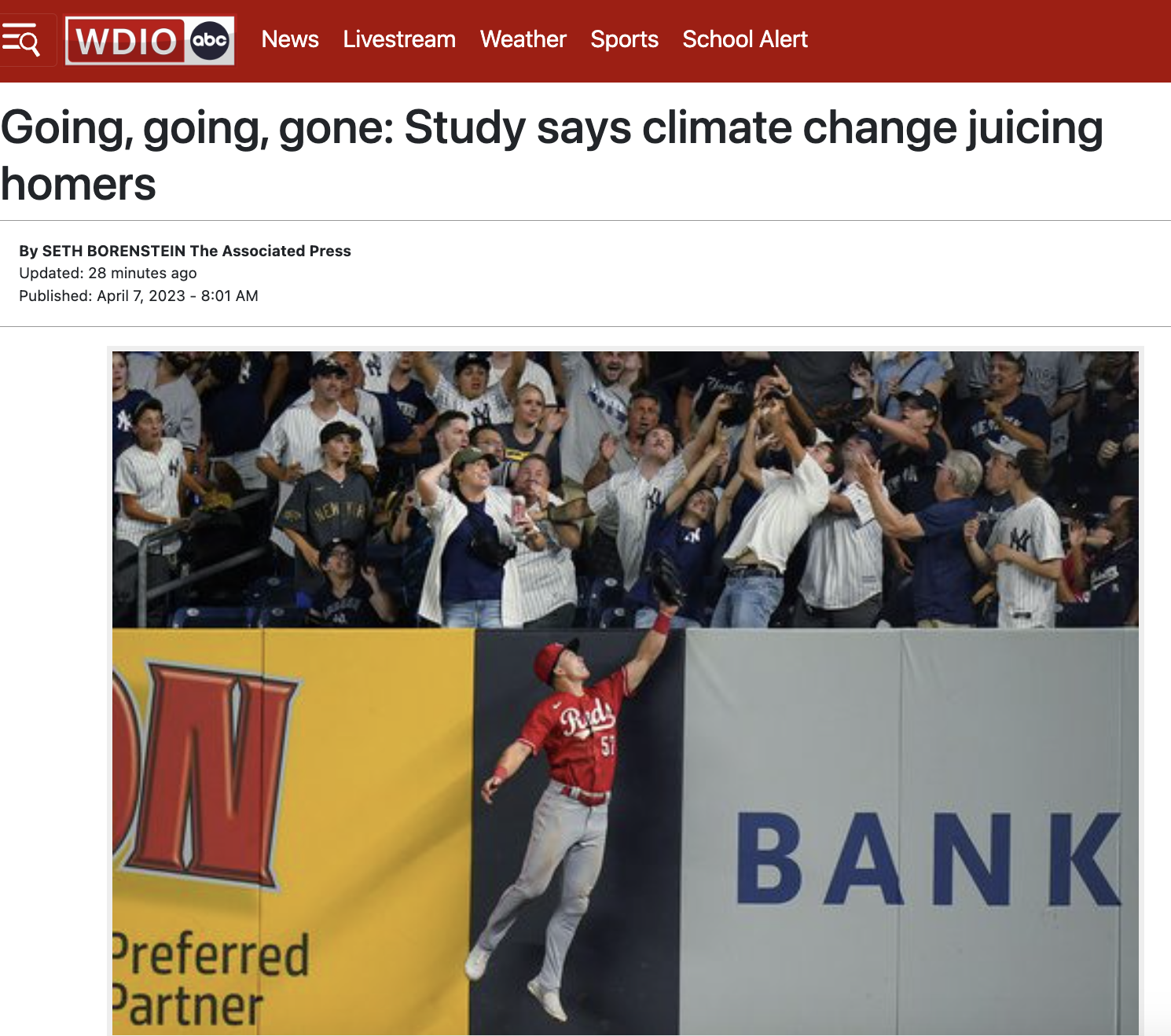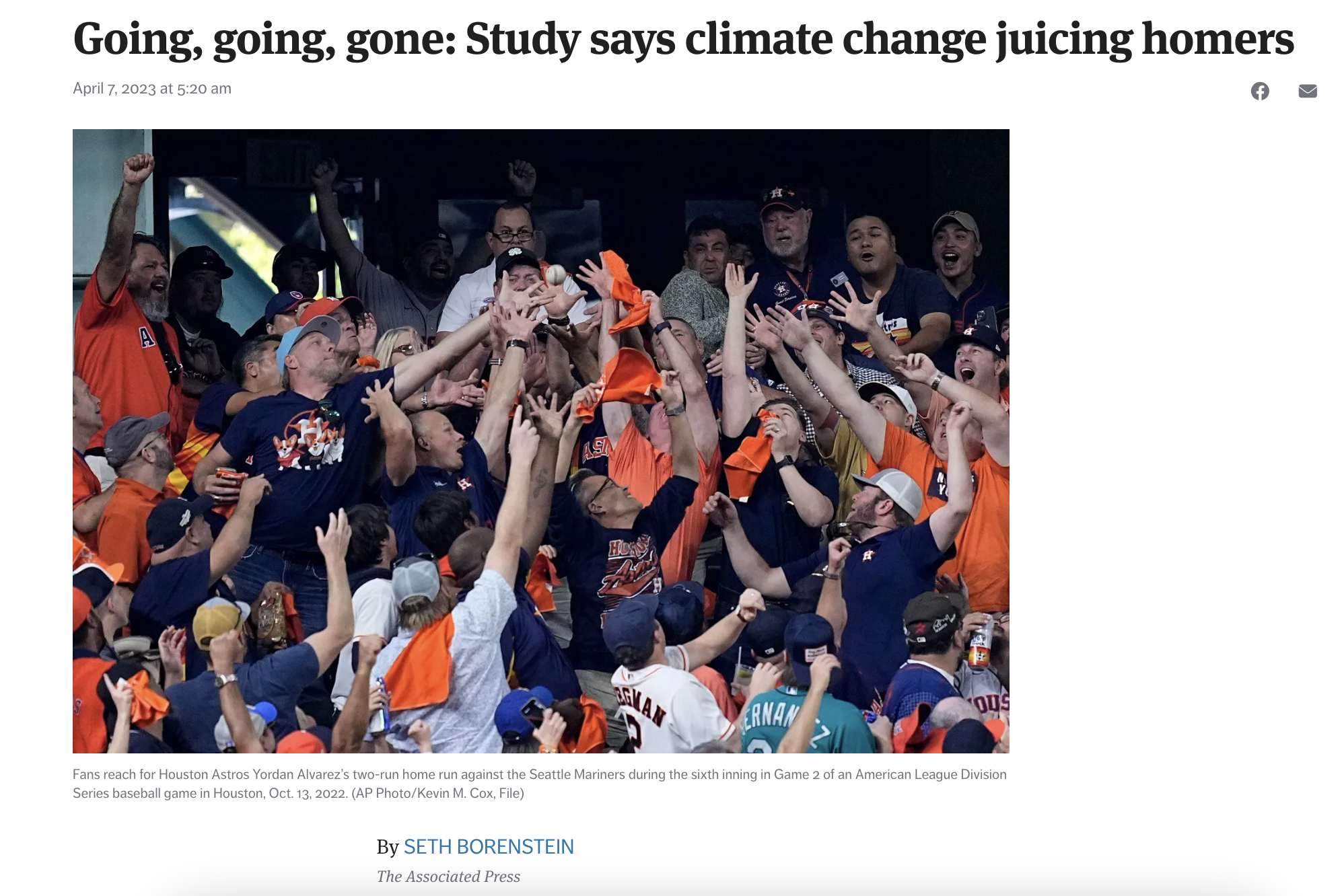There is an obvious control group, AAA baseball (completely ignored in this new paper)
And home runs are down in AAAhttps://t.co/zWzneW28fg
Maybe climate change only has effects in the major leagues?
Silly science is still fun! pic.twitter.com/Kkz136G1RF
— The Honest Broker (@RogerPielkeJr) April 7, 2023
Climate change did not lead to more home runs in Japan 1977-2003
Attribution science is tricky like that pic.twitter.com/GPEB65PID6
— The Honest Broker (@RogerPielkeJr) April 7, 2023
And climate change has not caused more home runs in NCAA D1 baseball
Climate attribution is a tricky business, I tell ya pic.twitter.com/iv4AtP0twv
— The Honest Broker (@RogerPielkeJr) April 7, 2023
https://rogerpielkejr.substack.com/p/climate-change-causes-home-runs
Excerpt: Pielke Jr.: “Thus, a more accurate reading of the paper’s quantitative conclusions is that climate change is a tiny, even insignificant, factor in MLB home run trends, easily swamped by everything else that can affect home runs. In our exchange, the paper’s co-author seems to have acknowledged this: “I think it’s straightforward to reason that one can have both a decline in HRs … while also having warming to date make a small contribution to enhanced HR likelihood.” Nuanced and accurate, to be sure, but not the stuff of headlines in newspapers, or these days apparently, representations of research in scientific journals. … No matter how you slice it, even using the most extreme scenario and taking the paper’s conclusions at face value, climate change is just not a big deal for home runs in baseball. And that should be OK, as not everything has to be reduced to climate.”
Climate Change Causes Home Runs – What we can learn from making everything about climate
Last week a new study claimed to have identified a causal relationship between climate change and home runs in Major League Baseball. The paper — Global warming, home runs, and the future of America’s pastime, by Callahan et al. — asserted, “Several hundred additional home runs per season are projected due to future warming.” Looking to the past, the paper asserts, “human-caused climate change decreased home runs between 1962 and 1995 and increased them thereafter.” Predictably, the legacy media loved it, as you can see below.

On Twitter, I commented that climate change didn’t have the same HR-boosting effects in other baseball leagues, with no similar home run trends in Japan, the AAA league or the NCAA — where in each instance home runs have declined in recent decades.
One of the authors of the paper contacted me, I suppose after seeing my Tweets, and explained:
Our model is not trying to predict home runs. It’s trying to estimate temperature’s effect on home runs. Those are, empirically, different endeavors.
Yes, I agree. However, contrary to what the author told me via email, the paper is centered on projecting future home runs — it even predicts an increase in home runs by MLB ballpark. The paper states clearly, and erroneously:
[T]hese model experiments allow us to quantify the influence of historical climate change on home run totals. They also allow us to project how home runs may change in the future with warming.
In response, this is what I said to the paper’s author about their methodology and misleading description of their methods:
Your methodology is formally a sensitivity analysis, which seeks to isolate a statistical relationship of temperature and home runs. I agree that such a sensitivity analysis simply does not allow for meaningful predictions or projections of future home runs . . . Of course, climate research is rife with studies (and reporting, such as the Wash Post article on your study) that confuse single-variable sensitivity analysis with meaningful projections (e.g., the effects of climate on crop yields is a textbook example of this).
The author, in his exchange with me, also explained clearly and accurately that there could be other factors beyond climate change that might explain the declines in other leagues that are at odds with the trends in home runs in MLB. Indeed. Were I a peer reviewer of this paper, I would have required that they repeat their analysis with data from Japan, AAA and NCAA, all of which is readily available, as are relevant climate data and model projections.
Patrick Brown of The Breakthrough Institute points out that the new study, taken at face value (which I do not, but let’s just posit that), asserts that since the 1970s an increase of about 0.04 HRs per game can be attributed to climate change out of a total increase of 0.75 HRs per game — or about 5% of the total increase.
Thus, a more accurate reading of the paper’s quantitative conclusions is that climate change is a tiny, even insignificant, factor in MLB home run trends, easily swamped by everything else that can affect home runs. In our exchange, the paper’s co-author seems to have acknowledged this: “I think it’s straightforward to reason that one can have both a decline in HRs … while also having warming to date make a small contribution to enhanced HR likelihood.” Nuanced and accurate, to be sure, but not the stuff of headlines in newspapers, or these days apparently, representations of research in scientific journals.
…
No matter how you slice it, even using the most extreme scenario and taking the paper’s conclusions at face value, climate change is just not a big deal for home runs in baseball. And that should be OK, as not everything has to be reduced to climate. Yet, the paper concludes dramatically:
“More broadly, our findings are emblematic of the widespread influence anthropogenic global warming has already had on all aspects of life.”
A lesson here is that we have created strong incentives in science, in the promotion of science and in journalism to reduce everything to climate. If you are on the climate beat you are most certainly not going to be discussing steroids in baseball, seam size, humidor practices or any of the other myriad factors related to home run production. The climate beat needs climate stories.
These incentives help us to understand what gets published, promoted and clicked. These incentives are also incredibly distorting to both journalism and, increasingly, to research. Baseball and climate might seem like a silly topic, but these dynamics can be found on far more important issues involving climate.
…
Full article here: https://rogerpielkejr.substack.com/p/climate-change-causes-home-runs
#


By SETH BORENSTEIN The Associated Press: Climate change is making major league sluggers into even hotter hitters, sending an extra 50 or so home runs a year over the fences, a new study found. Hotter, thinner air that allows balls to fly farther contributed a tiny bit to a surge in home runs since 2010, according to a statistical analysis by Dartmouth College scientists published in Friday’s Bulletin of the American Meteorological Society. They analyzed 100,000 major league games and more than 200,000 balls put into play in the last few years along with weather conditions, stadiums and other factors. “Global warming is juicing home runs in Major League Baseball,” said study co-author Justin Mankin, a Dartmouth climate scientist. It’s basic physics. … Both Nathan and the Dartmouth team found a 1% increase in home run likelihood with every degree the air warms (1.8% with each degree Celsius). Total yearly average of warming-aided homers is only 1% of all home runs hit, the Dartmouth researchers calculated. … The statistical analysis found no significant heat-aided homers at Tampa’s Tropicana Field, the only full-time domed stadium in Major League Baseball. …
Mankin called what’s happening “a fingerprint of climate change on our recreation.” Callahan said what’s been seen so far is nothing compared to projections of hundreds of extra homers in the future. In the worst-case warming trajectory – which some scientists say the world is no longer on based on recent emissions – there would be about 192 warming-aided homers a year by 2050 and around 467 hot home runs by the year 2100.
#
The wacky world of climate change!Flashback: Mid-June in Calif.: Oakland baseball player blames hitting woes on cold weather
Won’t global warming decrease home runs since the bats will be impacted by beetles?! Warmer temps will be offset by the subpar bats due to climate change-induced beetles!




